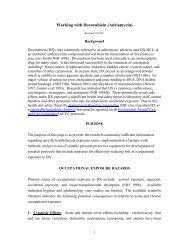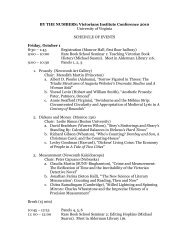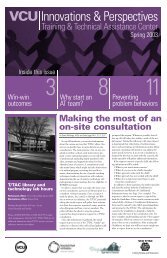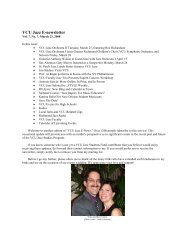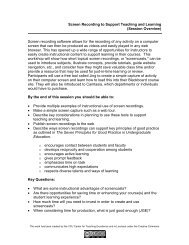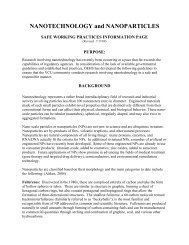Acupuncture for the Treatment of Cocaine Addiction
Acupuncture for the Treatment of Cocaine Addiction
Acupuncture for the Treatment of Cocaine Addiction
Create successful ePaper yourself
Turn your PDF publications into a flip-book with our unique Google optimized e-Paper software.
200 S. Kelly et al.TABLE 1Means (SDS) <strong>for</strong> <strong>Cocaine</strong> Use Variables <strong>for</strong> <strong>Treatment</strong> Completers (n = 30) at Baseline and Over <strong>the</strong> Course<strong>of</strong> <strong>the</strong> B-Week Study by Type <strong>of</strong> Needle Puncture <strong>Treatment</strong> ReceivedStudy Week0 1 2 3 4 5 6Urine ToxicologyPercent <strong>Cocaine</strong> PositiveActive acupunctureControl needle punctureSelf-ReportGrams Used per WeekActive acupunctureControl needle punctureNumber <strong>of</strong> Days Used Per WeekActive acupunctureControl needle punctureCraving rating: (Scale: 0- 10)Active acupunctureControl needle puncture93.7 71.9 65.6(25.0) (40.7) (47.3)92.9 82.1 71.4(26.7) (31.7) (37.8)1.3(2.9)1.7(3.5)1.4 0.3(3.0) (0.4)1.1 0.9(1.4) (0.9)2.2 1.8 1.2(1 .a) (1 .a) (1.2)2.1 1.8 2.0(1.9) (1.8) (1.4)3.3 1.6 1.1(3.5) (2 3) (1.3)3.3 2.3 2.1(3.4) (2.4) (2.1)62.5 65.6 56.2 53.1(46.5) (43.7) (44.2) (46.4)67.9 71.4 67.9 57.1(46.4) (42.6) (42.1) (43.2)0.2(0.3)0.9(1.4)0.9(1 .O)1.5(1.5)0.7(1.4)2.0(2.1)0.2 0.6 0.2(0.3) (1.a (0.5)0.7 0.5 0.2(1 .O) (0.7) (0.3)0.6 1.0 0.6(0.6) (1 .O) (1 .O)1.4 1.1 0.6(1.7) (1 .O) (0.7)0.6 0.6 0.4(1 .O) (0.9) (0.9)2.0 1.8 2.7(2.4) (2.5) (2.7)Note. Mtssed urine = positive <strong>for</strong> cocalne metabolite; missed self-report = weekly mean <strong>for</strong> subject’s treatment groupBeck Depression Inventory. There was a main effect<strong>for</strong> Time (F[ 1, 281 = 9.95, p < .004). Depression decreasedsignificantly across <strong>the</strong> 6-week study [PretreatmentM = 19.6 (+- 12.4); Posttreatment M = 14.1(+ 10.6)]. There was no main effect <strong>for</strong> type <strong>of</strong> acupuncture,and <strong>the</strong>re was no significant interaction.ASI Composite Scores. There were main effects <strong>for</strong>Time <strong>for</strong> <strong>the</strong> following composite scores: Intensity <strong>of</strong>Drug Problems (F[ 1, 281 = 7.40, p < .Ol ; pretreatmentM= .35 (k.13); posttreatment M= .29 (&.ll)), andIntensity <strong>of</strong> Legal Problems (F[ 1,281 = 6.20, p < .02;pretreatment M = .07 [*. 121; posttreatment M = .03[*.07]). There were no main effects <strong>for</strong> type <strong>of</strong> acupunctureand no significant interactions.SCL-90 Scores. There were main effects <strong>for</strong> Time <strong>for</strong><strong>the</strong> following subscale scores: Somatization (F[l, 281 =8.05, p < .008; pre M = 1.27 [+ .91]; post M = 0.92[+-.69]); Depression (F[l, 281 = 7.57, p < .Ol; preM=1.35[+.99];postM=1.01 [+.93]);Anxiety(F[1,28] =9.28, p < .005; pre M = 1.12 i-t.901; post A4 = 0.74f&77]); Phobic Anxiety (F[ 1,281 = 5.50, p < .03; preM = 0.76 [k .75]; post M = 0.53 [+ .68]); and Psychoticism(F[l, 281 = 6.03, p < .02; pre M= 0.81 [*.74];post M= 0.61 + .66]). There were no main effects <strong>for</strong>type <strong>of</strong> acupuncture, and no significant interactions.Attitudes Toward and SubjectiveResponses to <strong>Acupuncture</strong><strong>Treatment</strong> Credibility Scale. Means and standard deviations<strong>for</strong> scores on <strong>the</strong> TCS are shown in Table 2.A series <strong>of</strong> 2 (type <strong>of</strong> acupuncture) x 2 (pre/post 6-weektreatment period) mixed ANOVAs were conducted on<strong>the</strong> five TCS items. Collapsed across type <strong>of</strong> acupuncture,confidence that acupuncture would help with druguse, and confidence in recommending acupuncture toa friend increased from pretreatment to post-dweektreatment (F[l, 281 = 5.03, p < .03, and F[l, 281 =14.55, p < .OOl, respectively). There was no significantchange in how logical <strong>the</strong> treatment seemed ei<strong>the</strong>r <strong>for</strong>drug use or <strong>for</strong> o<strong>the</strong>r health problems, or in subjects’confidence that <strong>the</strong> treatment would be useful <strong>for</strong> <strong>the</strong>treatment <strong>of</strong> o<strong>the</strong>r health problems. There were nomain effects <strong>for</strong> type <strong>of</strong> acupuncture on any <strong>of</strong> <strong>the</strong> fiveitems and no significant interactions. Pearson correlationsrevealed no significant relation between confidencein acupuncture and percent <strong>of</strong> urines positive <strong>for</strong>cocaine submitted during <strong>the</strong> course <strong>of</strong> <strong>the</strong> study, ei<strong>the</strong>rby type <strong>of</strong> needle puncture received, or collapsedacross needle puncture conditions.Acute Effects <strong>of</strong> <strong>Acupuncture</strong> (AEA) Scales. A series<strong>of</strong> 2 (type <strong>of</strong> acupuncture) x 2 (pre/post acupuncture
ll<strong>Acupuncture</strong> <strong>for</strong> <strong>Cocaine</strong> Dependence 201TABLE 2<strong>Treatment</strong> Credibility Scale Means (+SD) Preacupuncture and Postacupuncture <strong>Treatment</strong> <strong>for</strong><strong>Treatment</strong> Completers (n = 30)How confident are you that acupuncture canhelp you with your drug problem?*Active acupunctureControl needle punctureHow confident are you that acupuncture canhelp you with any health problems you have?Active acupunctureControl needle punctureHow confident are you in recommendingacupuncture to a friend with similar problems?*Active acupunctureControl needle punctureHow much sense does it make that acupuncturewould help you with your drug problem?Active acupunctureControl needle punctureHow much sense does it make that acupuncturewould help you with o<strong>the</strong>r health problems?Active acupunctureControl needle puncture-Pretreatment2.75 (k0.86)2.64 (kO.63)2.62 (k0.88)2.54 (kO.65)2.56 (kl.21)2.50 (kO.94)2.43 (kO.89)2.79 (kO.89)2.25 (kO.93)2.21 (t-0.97)Posttreatment3.31 (kO.79)3.00 (* 1.04)2.87 (kO.72)2.79 (k0.89)3.19 (kO.83)3.43 (kO.94)3.00 (kO.97)3.00 (kO.55)2.50 (+l .09)2.57 (kO.76)Note. Scale. 0 (not at all) to 4 (extremely).*Significant difference pre/post 6-week treatment collapsed across type <strong>of</strong> needle puncture. There wereno differences between <strong>the</strong> two types <strong>of</strong> needle puncture on <strong>the</strong>se measures <strong>of</strong> treatment credibility.session) mixed ANOVAs were conducted on <strong>the</strong> eight There were several main effects <strong>for</strong> Time. CollapsedAEA items. The mean subjective responses to a sin- across type <strong>of</strong> needle insertion, nervousness and degleacupuncture session (active or control needle punc- pression decreased (F[ 1, 151 = 7.40, p < .02 and F[ 1,ture) during <strong>the</strong> first week <strong>of</strong> treatment are presented 151 = 11.12, p < .005, respectively), and relaxation,in Table 3. sleepiness, and ligh<strong>the</strong>adedness increased (F[ 1, 151 =TABLE 3Acute Subjective Effects <strong>of</strong> a Single <strong>Acupuncture</strong> Session During <strong>the</strong> First Week <strong>of</strong> <strong>Treatment</strong>Active (n = 7)Control (n = 10)Pre-SessionPost-SessionPre-SessionPost-SessionNervous *DepressedRelaxed lHappySleepy lEnergeticBody feels heavyLigh<strong>the</strong>adedPain:Upon insertion/earsUpon insertion/handsDuring session1.29 (1.11)1 .71 (1 .25)1 .14 (0.69)1 .42 (0.79)0.71 (0.76)1.42 (0.53)0.71 (0.95)0.43 (0.79)-0.29 (0.76)0.71 (0.76)3.00 (1.15)1 .86 (0.69)1.71 (0.76)0.86 (0.69)1 .OO (0.82)1.00 (1.00)0 50 (0.76)0.29 (0.76)0.25 (0.46)0.60 (0.97)1.10 (1.20)1.80 (1.40)1.40 (0.84)0.80 (1.03)0.30 (0.48)1.10 (1.20)0.50 (0.71)-0.30 (0.48)0.60 (0.70)2.60 (0.97)1.60 (0.70)1.60 (1.35)1.20 (0.92)0.70 (1.06)1.20 (0.42)0.45 (0.69)0.20 (0.42)0.18 (0.40)Note. Scale 0 (not at all) to 4 (extremely).‘Significant changes preipost session collapsed across type <strong>of</strong> needle puncture. There were no significantdifferences between <strong>the</strong> two types <strong>of</strong> needle puncture on any measured acute effect <strong>of</strong> a singleacupuncture session.
202 S. Kelly et al.21.32, p < .OOl; F[l, 151 = 17.25, p < .OOl; and F[l,151 = 7.23, p < .02, respectively). There was no changepre/post session in feelings <strong>of</strong> happiness, energy, orheaviness. There were no main effects <strong>for</strong> type <strong>of</strong> acupunctureand no significant interactions. Comparingposttreatment pain ratings <strong>for</strong> active and control needlepuncture, t tests revealed no significant differencesin pain ratings between <strong>the</strong> two types <strong>of</strong> needle punctureconditions; as shown in Table 3 intensity <strong>of</strong> painei<strong>the</strong>r upon insertion <strong>of</strong> needles or during <strong>the</strong> course<strong>of</strong> <strong>the</strong> session was minimal <strong>for</strong> ei<strong>the</strong>r type <strong>of</strong> needleinsertion.Exploratory Analyses by HIV StatusHIV Status. There was good treatment retentionamong both HIV-negative and HIV-positive patients;77.8% (14/18) <strong>of</strong> HIV-positive patients and 72.7%(16/22) <strong>of</strong> HIV-negative patients completed <strong>the</strong> 6-weekstudy. There was a trend <strong>for</strong> HIV-positive patients whocompleted treatment to provide fewer cocaine-positiveurines during <strong>the</strong> course <strong>of</strong> <strong>the</strong> study (Mean = 54.2% <strong>of</strong>:34.6) than HIV-negative patients (Mean = 76.0% k30.1) (F[ 1,281 = 3.44, p < .07). In addition, 50% <strong>of</strong>HIV-positive patients (compared to 25% <strong>of</strong> HIVnegativepatients) were able to initiate abstinence bystudy completion.DISCUSSIONWe conducted a propaedeutic trial in order to investigateseveral issues critical to <strong>the</strong> design <strong>of</strong> a large-scalestudy <strong>of</strong> acupuncture <strong>for</strong> <strong>the</strong> treatment <strong>of</strong> cocaine addictionin methadone-maintained patients. Results,overall, showed a significant decrease in cocaine usefrom baseline, with good treatment retention. In addition,significant improvements were seen on a number<strong>of</strong> psychosocial measures (i.e., Beck depression,AS1 drug severity, and several SCL-90 subscales). Wefound no statistically significant difference between <strong>the</strong>active and control needle puncture treatments on anymeasure, with <strong>the</strong> exception <strong>of</strong> craving; <strong>the</strong> active acupuncturegroup reported significantly less craving <strong>for</strong>cocaine during <strong>the</strong> course <strong>of</strong> <strong>the</strong> study than did <strong>the</strong>control needle puncture group.Appropriateness <strong>of</strong> <strong>the</strong> Needle PunctureControl ConditionPower calculations were conducted to determine <strong>the</strong>sample size necessary to detect <strong>the</strong> difference betweenneedle puncture groups <strong>for</strong> percentage <strong>of</strong> urines testingpositive <strong>for</strong> cocaine during <strong>the</strong> course <strong>of</strong> <strong>the</strong> study(active: 69.17% [+35.67]; control: 78.33% [&28.54]).We calculated that with power at .80 and alpha at .05,196 subjects per treatment group would have been necessaryto detect this relatively small effect size <strong>of</strong> .28.This is a considerably larger sample than is suggestedby ei<strong>the</strong>r Lewith and Machin’s (1983) or Pomeranz’(1987) power calculations <strong>for</strong> detecting differences between“real” and “sham” acupuncture. Assuming thatsubjects in <strong>the</strong> active acupuncture group did, in fact,receive an optimally active treatment, several findingsfrom <strong>the</strong> current study suggest that <strong>the</strong> control needlepuncture procedure we used might have been a relatively“active” treatment. These include <strong>the</strong> small treatmenteffect size, lack <strong>of</strong> significant differences in <strong>the</strong>subjective ratings between <strong>the</strong> two groups after an acupuncturesession, as well as between <strong>the</strong> groups on <strong>the</strong>irratings <strong>of</strong> confidence in acupuncture ei<strong>the</strong>r pretreatmentor posttreatment - both increased. O<strong>the</strong>r researchersusing a needle puncture control conditionsimilar to that employed in this study-insertion <strong>of</strong>needles into <strong>the</strong>oretically “inactive” points close to activesites-have also reported overall reductions in illicitdrug use, but no significant differences betweentreatment groups (Jackson, Wells, Diaz, Staton, &Saxon, 1994). Lipton et al. (1994) employed pointsused <strong>for</strong> treating skeletomuscular disorders, which arewithin 5 mm <strong>of</strong> active points and which are not indicated<strong>for</strong> <strong>the</strong> treatment <strong>of</strong> addiction, as control points.They, too, speculate that <strong>the</strong>se control points may havebeen too “active.”Our study does not, <strong>of</strong> course, demonstrate that <strong>the</strong>control sites we employed were entirely inappropriate;in fact, means on all drug outcome measures were in<strong>the</strong> direction <strong>of</strong> an effect <strong>for</strong> <strong>the</strong> active needle puncturecondition. It is also possible that an undocumented,idiosyncratic aspect <strong>of</strong> our acupuncturist’stechnique may have influenced results. However, inview <strong>of</strong> <strong>the</strong> considerable investment <strong>of</strong> resourcesneeded to conduct clinical trials, we think that siteswith less apparent activity should be chosen as controlsin future studies. A promising strategy might beto locate auricular control points entirely outside <strong>of</strong><strong>the</strong> regions <strong>of</strong> active points. For drug addiction studiesthis would mean that control points should not belocated within <strong>the</strong> ear concha. We have begun to investigate<strong>the</strong> ear helix as a possible location <strong>for</strong> auricularcontrol points, in particular, sites on <strong>the</strong> helix thatare not hypo<strong>the</strong>sized to be active treatments <strong>for</strong> addictionin any system <strong>of</strong> acupuncture. We are conductinga single-blind study in which patients provideratings after needle insertion into helix points, activesites, and two “control” configurations-<strong>the</strong> controlused in <strong>the</strong> present study, and <strong>the</strong> control used by Liptonet al. (1994).-Preliminary findings suggest that<strong>the</strong> helix points are perceived by patients as <strong>the</strong> leastactive (Margolin, Avants, Chang, Birch, & Kosten, inpress).
204 S. Kelly et al.cha and <strong>the</strong> helix. The need to isolate patients in orderto maintain <strong>the</strong> blind may conflict with <strong>the</strong> creation<strong>of</strong> a setting in which patients can observe each o<strong>the</strong>rduring treatment. The proper resolution <strong>of</strong> <strong>the</strong>se twoconditions would need to be worked-out be<strong>for</strong>e embarkingon a full-scale study, <strong>for</strong> example, by segregatingpatients by group by treatment assignment.5. Experience <strong>of</strong> Study Acupuncturists. Experience inthis study rein<strong>for</strong>ced our opinion that acupuncturestudies with needle puncture controls place special demandson study acupuncturists and, <strong>the</strong>re<strong>for</strong>e, requirepractitioners who possess technique <strong>of</strong> <strong>the</strong> highest caliberwho are able to work within <strong>the</strong> strictures <strong>of</strong> a researchprotocol. <strong>Acupuncture</strong> in research studiesshould be delivered only by acupuncturists who havehad extensive experience in full-body and auricularacupuncture and who have had considerable practicehoning <strong>the</strong> control procedure.We would like to briefly discuss an alternative interpretation<strong>of</strong> our data. Our findings could be interpretedas patients’ response to a novel, somewhat invasive,procedure in both groups-that is, to <strong>the</strong> administration<strong>of</strong> an active placebo. Fur<strong>the</strong>rmore, it is possiblethat <strong>the</strong> overall improvements found in drug use andpsychosocial functioning were due to nonspecific factorssuch as daily staff attention, increased staff andpatient monitoring <strong>of</strong> drug use, or to a relaxing effect<strong>of</strong> reclining <strong>for</strong> an hour in a quiet room each day.The addition <strong>of</strong> a relaxation control group in futurestudies would allow <strong>for</strong> an assessment <strong>of</strong> some <strong>of</strong> <strong>the</strong>nonspecific effects <strong>of</strong> acupuncture treatments upontreatment outcome. However, given <strong>the</strong> present state<strong>of</strong> our knowledge concerning acupuncture, <strong>the</strong>re is noobvious way to definitively resolve issues concerning<strong>the</strong> effect <strong>of</strong> placebo response on treatment outcome.In order <strong>for</strong> this to be accomplished, <strong>the</strong> needle puncturecontrol condition would have to be shown to beinert, a priori and independently <strong>of</strong> patient response,like a pill placebo in pharmaco<strong>the</strong>rapy studies. <strong>Acupuncture</strong>research methodology is not sufficiently advancedto conduct “conclusive” studies. In our opinion,findings from <strong>the</strong> current study, such as overall improvementin outcome measures related to addiction,good treatment retention, relatively favorable abstinencerates in <strong>the</strong> 6th week <strong>of</strong> <strong>the</strong> study, and <strong>the</strong> overallresponse <strong>of</strong> HIV positive patients to acupuncture,suggest that fur<strong>the</strong>r investigations <strong>of</strong> this treatmentmodality are warranted. We hope that <strong>the</strong>se investigationswill be characterized by increasing methodologicalrefinement and that <strong>the</strong> current study will havecontributed to this goal.REFERENCESBall, J., Corty, E., Bond, H., Myers, C., & Tommasello. A. (1987).The reduction <strong>of</strong> intravenous heroin use, non-opiate abuse andcrime during methadone maintenance treatment: Fur<strong>the</strong>r findings.In L.S. Harris (Ed.), Proceedings <strong>of</strong> <strong>the</strong> 41st Annual ScientificMeeting <strong>of</strong> <strong>the</strong> Committee on Problems <strong>of</strong> DrugDependence (NIDA Research Monograph Series, Vol. 81, pp.224-230).Beck, A.T., Ward, C.H., Mendelson, M., Mock, J., & Erbaugh,J. (1961). An inventory <strong>for</strong> measuring depression. Archives <strong>of</strong>General Psychiatry, 4, 561-571.Brumbaugh, A.G. (1993). <strong>Acupuncture</strong>: New perspectives in chemicaldependency treatment. Journal <strong>of</strong> Substance Abuse <strong>Treatment</strong>,10, 35-43.Bullock, M., Culliton, P., & Olander, R.T. (1989). Controlled trial <strong>of</strong>acupuncture <strong>for</strong> severe recidivist alcoholism. Lancet, ii, June 24,1435-1439.Chiu, L.M. (1986). Mind, body, and i/mess in a Chinese medicaltradition. Unpublished doctoral <strong>the</strong>sis, Harvard University, Cambridge,MA.Condelli, W.S., Fairbank, J.A., Dermis, M.L., & Rachal, J.V. (1992).<strong>Cocaine</strong> use by clients in methadone programs: Significance,scope, and behavioral interventions. Journal <strong>of</strong> Substance Abuse<strong>Treatment</strong>, 8, 203-212.Derogatis, L.R., Lipman, R.S., & Covi, L. (1973). SCL-90: An outpatientpsychiatric scale-Preliminary report. PsychopharmacologyBulletin, 4, 13-28.Jackson R., Wells, E.A., Diaz, O.R., Staton, V., & Saxon, A.J.(1994). <strong>Acupuncture</strong> as an adjunct to services provided at methadonetreatment facilities. Paper presented at <strong>the</strong> 56th annualmeeting <strong>of</strong> <strong>the</strong> College on Problems <strong>of</strong> Drug Dependence, PalmBeach, FL.Kosten, T.R., Morgan, C.M., Falcioni, J., & Schottenfeld, R.S.(1992). Pharmaco<strong>the</strong>rapy <strong>for</strong> cocaine-abusing methadone maintainedpatients using amantadine or desipramine. Archives <strong>of</strong>General Psychiatry, 49, 894-899.LeBars, D., Dickenson, A.H., & Besson, J.M. (1979). Diffuse noxiousinhibitory controls (DNIC): Effects on dorsal horn convergentneurones in <strong>the</strong> rat. Pain, 6, 283-304.Lewith, G.T., & Machin, D. (1983). On <strong>the</strong> evaluation <strong>of</strong> <strong>the</strong> clinicaleffects <strong>of</strong> acupuncture. Pam, 16, 11 l-127.Liao, S.J., Lee, M.H.M., Ng, L.K.Y. (1994). Principlesandpractice<strong>of</strong> contemporary acupuncture. New York: Marcel Dekker.Lipton, D., Brewington, V., & Smith, M.O. (1994). <strong>Acupuncture</strong>and crack addicts: A single blind placebo test <strong>of</strong> efficacy. Journal<strong>of</strong> Substance Abuse <strong>Treatment</strong>, 11, 205-215.Margolin, A., Avants, S.K., Chang, P., & Kosten, T.R. (1993a).Auricular acupuncture <strong>for</strong> <strong>the</strong> treatment <strong>of</strong> cocaine dependencein methadone-maintained patients. American Journal on <strong>Addiction</strong>s,2, 194-200.Margolin, A., Avants, S.K., Chang, P., Birch, S., & Kosten, T.R.(in press). A single blind investigation <strong>of</strong> four auricular needlepuncture configurations. American Journal <strong>of</strong> Chinese Medicine.Margolin, A., Chang, P., Avants, S.K., & Kosten, T.R. (1993b).Effects <strong>of</strong> sham and real auricular needling: Implications <strong>for</strong> trials<strong>of</strong> acupuncture <strong>for</strong> cocaine addiction. American Journal <strong>of</strong>Chinese Medicine, 21, 103-I 11.McLellan, A.T., Grossman, D.S., Blain, J.D., & Haverkos, H.W.(1993). <strong>Acupuncture</strong> treatment <strong>for</strong> drug abuse: A technical review.Journal <strong>of</strong> Substance Abuse <strong>Treatment</strong>, 10, 569-576.McLellan, A.T., Luborsky, L., Woody, G.E., & O’Brien, C.P.(1980). An improved diagnostic instrument <strong>for</strong> substance abusepatients: The <strong>Addiction</strong> Severity Index. Journal <strong>of</strong> Nervous andMental Disease, 168, 26-33.O’Conner, J., & Bensky, D. (1981). <strong>Acupuncture</strong>: A comprehensivetext. Seattle: Eastland Press.Pomeranz, B. (1987). Scientific basis <strong>of</strong> acupuncture. In G. Stux& B. Pomeranz (Eds.), <strong>Acupuncture</strong>: Textbook and atlas. Berlin:Springer-Verlag.Rawson, R.A., McCann, M.J., Hasson, A.J., & Ling, W. (1994).<strong>Cocaine</strong> abuse among methadone maintenance patients: Are
<strong>Acupuncture</strong> <strong>for</strong> <strong>Cocaine</strong> Dependence 205<strong>the</strong>re effective treatment strategies? Journal <strong>of</strong> PsychoactiveDrugs, 26, 129-136.Smith, M.O. (1988). <strong>Acupuncture</strong> treatment <strong>for</strong> crack: Clinical survey<strong>of</strong> 1,500 patients treated. American Journal <strong>of</strong> Acupunclure,16, 241-247.ter Reit, G., Kleijen, .I., & Knipshild, P. (1990). A meta-analysis <strong>of</strong>studies into <strong>the</strong> effect <strong>of</strong> acupuncture on addiction. British Journal<strong>of</strong> General Practice, 40, 379-382.Ulett, G.A. (1992). Beyond Yin and Yang. St. Louis, MO: WarrenH. Green.Vincent, C. (1990). Credibility assessments in trials <strong>of</strong> acupuncture.Complementary Medical Research, 4, 8-11~Wiseman, N., & Ellis, A. (1985). Fundamentals <strong>of</strong> Chinese meditine,Brookline, MA: Paradigm Publications.



